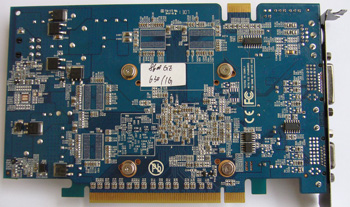Galaxy GeForce 8600 GE
Galaxy GeForce 8600 GE can range from 600-650MHz base clock (25MHz shy of the G84 clock of 8600 GTS at the top end of that range), with either 256MiB or 512MiB of memory on-board at 1000MHz (2000MHz DDR of course). Our sample came clocked at 630MHz (1400MHz hot clock, 50MHz shy from a 8600 GTS) with 256MiB of Samsung GDDR3.
The K4J52324QE-BJ1A chips are lead-free bins of Samsung's 512Mib part, rated to 1000MHz at 1.9V and run at that by Galaxy. To put the clocks in to perspective, 8600 GT is 540/700 for base/mem, whereas 8600 GTS is 675/1000, so Galaxy's GE sits somewhere between and obviously closer to GTS than GT. It's a full G84 underneath; so that's two clusters (32 SPs total), two quad ROPs, 128-bit external memory bus, VP2 video processor and support for D3D10 via NVIDIA's current architecture.
A closer look at the sample board shows it doesn't have the pair of DVI ports that most GeForce 8600 products do, and nor does it sport HDCP on the DVI port, making a little less suitable for media playback duties than it could be. You may not care for HDCP support, however, and some 8600 GEs may well support it (Galaxy list it as optional, so check your product box carefully). The other video output port supports HDTV output via a supplied component dongle, which you'll see on the following page.
The cooler is the big deal here and obviously non-reference as far as original equipment is concerned. We found noise levels to be low and without the hiss that characterises the original NVIDIA fansink for 8600 GT or GTS, making it very appealing from a noise point of view. Note that it spins at one speed all of the time, regardless of GPU load or temperature, so it might not be as quiet as competing boards at idle, but it's not so loud that we think you'd hear it too much over other constantly spinning fans in your system.
SLI is also supported at the hardware level with the bridge connector present on the PCB. Like the GeForce 8600 GTS (but unlike the GT), Galaxy's 8600 GE requires you to connect an external power source, despite 8600 GTS being quoted as requiring 71W at peak, and the GE being slower than that.
The off-the-record reason it's there is for partner board overclocking, so there's the real possibility that 630MHz -- especially with the cooler it sports -- is just a starting point if you grab an 8600 GE and fancy trying for more free performance. We didn't have the time to overclock our sample, however.
As you can see from that shot of two of the DRAMs, the cooler, sat centrally on the G84 chip, pushes the air it draws in via the central opening out over those two pictured memories. It's not the best place in almost any chassis to exhaust exchanged heat, so Galaxy rely on the fact that a decently-clocked G84 doesn't actually throw out that much heat, so that 8600 GE users won't suffer much worse case thermals than they might otherwise enjoy with another G84-based product.
So the cooler is nice and quiet but not too optimal in terms of overall chassis thermals, and it keeps the just-shy-of-GTS GPU and memory configuration running well at the stated frequencies, with likely a good chunk of headroom to boot.




